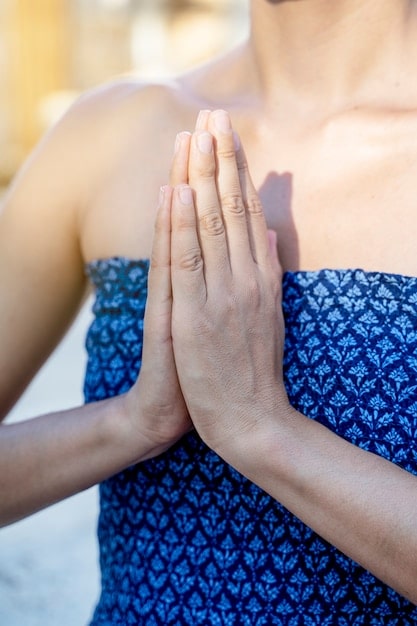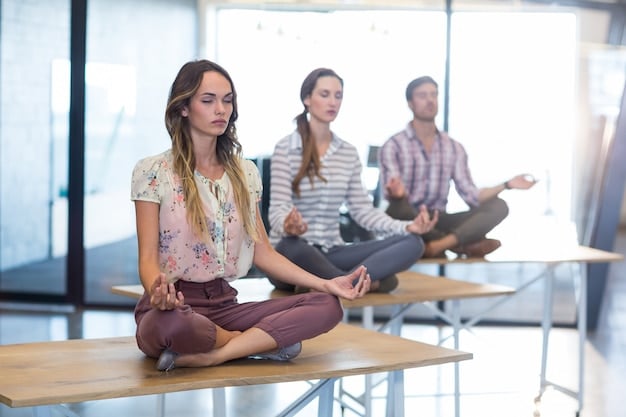Unlock Your Inner Power: Pranayama Breathwork for Yoga Enhancement

Pranayama, the yogic practice of breath control, can significantly enhance your yoga practice by improving focus, increasing energy flow, and promoting deeper relaxation. Integrating specific breathing techniques with asanas (poses) amplifies the physical and mental benefits of yoga.
Unlock the hidden potential within your yoga practice through the ancient art of pranayama. By mastering the power of breath, you can deepen your connection to your body, enhance your mental clarity, and supercharge your overall well-being. Discover the power of breathwork: using pranayama to enhance your yoga practice like never before.
Understanding the Foundation: What is Pranayama?
Pranayama, often translated as “breath control,” is a core aspect of yoga that goes beyond simple breathing exercises. It involves specific techniques designed to regulate and expand prana, the vital life force energy within us. By mastering pranayama, we can influence our physical, mental, and spiritual states, laying a solid foundation for our asana practice.
Unlike regular breathing, pranayama techniques involve conscious manipulation of the breath to achieve specific effects. Different methods can calm the nervous system, energize the body, improve focus, and promote emotional balance. Ultimately, through pranayama, we cultivate a deeper awareness of the breath and its profound impact on our overall health.
The Meaning of Prana: Life Force Energy
Prana is often described as the vital life force or energy that permeates the entire universe and sustains all living beings. In the context of yoga, prana is understood as the energy that flows through our bodies, influencing our physical, mental, and emotional well-being. Pranayama techniques are designed to increase, regulate, and direct the flow of prana within us.
When prana flows freely and abundantly, we experience greater vitality, clarity, and overall health. However, when prana becomes blocked or stagnant, it can lead to various physical and mental imbalances. Through consistent pranayama practice, we can remove these blockages, allowing prana to circulate freely, promoting optimal health and well-being.
- Prana is the vital life force that sustains all living beings.
- Pranayama techniques increase, regulate, and direct the flow of prana.
- Free-flowing prana promotes vitality, clarity, and overall health.
- Blocked prana can lead to physical and mental imbalances.
In essence, pranayama is a powerful tool for harnessing and directing the life force energy within us, leading to enhanced physical, mental, and spiritual well-being. By incorporating these techniques into our yoga practice, we can unlock a deeper level of awareness and transformation.
Benefits of Integrating Pranayama with Your Yoga Practice
Incorporating pranayama into your yoga practice can amplify the benefits significantly. Far beyond just physical postures, the synergy between breathwork and asanas creates a more holistic and transformative experience, leading to greater physical strength, mental clarity, and emotional balance.
By integrating pranayama, you can deepen your stretches, improve your balance, and enhance your overall performance in yoga poses. The combination of breath control and physical movement promotes a greater sense of body awareness, allowing you to move with more intention and precision.
Physical Benefits: Enhanced Strength and Flexibility
Pranayama techniques can improve oxygenation of the muscles, leading to increased strength and flexibility. Specific breathing methods can release tension in the body, allowing for deeper stretches and greater range of motion. The mindful focus on breath also enhances body awareness, reducing the risk of injuries.
Consistent pranayama practice can also improve cardiovascular health, boost the immune system, and promote better sleep. By reducing stress and anxiety, breathwork supports overall physical well-being, creating a healthier foundation for your yoga practice.

Mental Benefits: Clarity and Focus
Pranayama has a profound impact on mental clarity and focus. Specific breathing techniques can calm the mind, reduce anxiety, and improve concentration. By quieting the mental chatter, pranayama allows for deeper meditation and a greater sense of inner peace.
The mindful focus on breath creates a sense of presence, anchoring you to the present moment and away from distractions. This heightened awareness can extend beyond the yoga mat, improving focus and productivity in daily life.
- Improved oxygenation of muscles.
- Reduced tension and improved range of motion.
- Enhanced cardiovascular health and immune function.
- Increased mental clarity and focus.
Ultimately, integrating pranayama with yoga creates a powerful synergy that enhances both physical and mental well-being. By harnessing the power of breath, you can unlock a deeper level of transformation and experience the full benefits of your yoga practice.
Essential Pranayama Techniques for Yoga Practitioners
Several pranayama techniques are particularly beneficial for yoga practitioners. These methods can be easily integrated into your practice to enhance the physical and mental benefits of your asanas. Understanding the specific goals and techniques of each method will allow you to tailor your breathwork to your individual needs.
Each pranayama technique has unique effects on the body and mind. Some techniques are energizing and stimulating, while others are calming and grounding. It’s important to practice these methods under the guidance of a qualified instructor initially to ensure proper technique and safety.
Ujjayi Breath: The Victorious Breath
Ujjayi breath, often referred to as the “victorious breath,” is a foundational pranayama technique used extensively in yoga. This technique involves creating a slight constriction in the back of the throat, producing a soft, oceanic sound with each inhale and exhale. Ujjayi breath helps to focus the mind, regulate the breath, and generate internal heat.
The gentle sound of the breath serves as a constant reminder to stay present and focused during your yoga practice. Ujjayi breath also helps to stimulate the parasympathetic nervous system, promoting relaxation and reducing stress. This technique can be particularly beneficial during challenging yoga poses, helping you to maintain focus and control.
Kapalabhati Breath: The Skull Shining Breath
Kapalabhati breath, also known as the “skull shining breath,” is an energizing and detoxifying pranayama technique. This method involves forceful exhalations followed by passive inhalations. Kapalabhati breath helps to clear the nasal passages, stimulate the abdominal organs, and invigorate the mind.
It is important to practice Kapalabhati breath with caution, especially if you have high blood pressure, heart problems, or are pregnant. This technique should be performed on an empty stomach, and it is best to start with short rounds, gradually increasing the duration as you become more comfortable.
- Ujjayi Breath: Calms the mind, regulates breath, and generates internal heat.
- Kapalabhati Breath: Clears nasal passages, stimulates abdominal organs, and invigorates the mind.
- Nadi Shodhana: Balances the nervous system, reduces stress, and promotes mental clarity.
- Bhramari Breath: Calms the mind, relieves anxiety, and enhances concentration.
These essential pranayama techniques can be easily integrated into your yoga practice to enhance the physical and mental benefits of your asanas. By mastering these methods, you can deepen your connection to your body, quiet the mind, and cultivate a greater sense of inner peace. Remember to practice these techniques with awareness and under the guidance of a qualified instructor initially.
Integrating Pranayama into Different Yoga Styles
The beauty of pranayama lies in its versatility, seamlessly weaving into various yoga styles to amplify their inherent benefits. Whether you’re a fan of the dynamic flow of vinyasa or the sustained poses of hatha, integrating breathwork can transform your experience.
Each yoga style offers unique opportunities to synchronize breath with movement, creating a harmonious practice that nurtures both body and mind. By understanding how to adapt pranayama techniques to different styles, you can unlock the full potential of your yoga journey.
Vinyasa Yoga: Synchronizing Breath with Movement
Vinyasa yoga, known for its fluid sequences of poses linked together with breath, provides an excellent opportunity to integrate pranayama. Ujjayi breath is commonly used in vinyasa to maintain focus, regulate the breath, and generate internal heat throughout the practice. The synchronization of breath with movement creates a meditative flow, enhancing both physical and mental benefits.
In vinyasa, each movement is coordinated with an inhale or exhale, creating a seamless transition between poses. This synchronization helps to deepen stretches, improve balance, and cultivate body awareness. By maintaining a steady and controlled breath, you can navigate challenging sequences with greater ease and grace.
Hatha Yoga: Deepening Poses with Breath Awareness
Hatha yoga, characterized by its slower pace and sustained poses, offers a unique opportunity to explore breath awareness and deepen your connection to each asana. By focusing on your breath during longer holds, you can release tension, improve alignment, and enhance the therapeutic benefits of each pose.
In hatha yoga, various pranayama techniques can be incorporated into the practice, such as alternate nostril breathing (nadi shodhana) to balance the nervous system or bee breath (bhramari) to calm the mind. By consciously directing your breath, you can tap into a deeper level of relaxation and presence, transforming your hatha yoga practice into a moving meditation.

Ultimately, integrating pranayama into different yoga styles is about finding the right balance between breath and movement. By experimenting with different techniques and listening to your body, you can create a personalized practice that nourishes your physical, mental, and spiritual well-being. Whether you prefer the dynamic flow of vinyasa or the sustained poses of hatha, pranayama can enhance your yoga journey and unlock its full potential.
Common Mistakes to Avoid in Pranayama Practice
While pranayama offers numerous benefits, it’s crucial to approach it with awareness and mindful attention to avoid common pitfalls. These mistakes can not only diminish the effectiveness of the practice but also lead to discomfort or even injury.
Understanding and avoiding these errors ensures that you can safely and effectively integrate pranayama into your yoga routine. It’s also advisable to seek guidance from a qualified yoga instructor, especially when starting out.
Forcing the Breath
One of the most common mistakes in pranayama is forcing the breath. This can lead to hyperventilation, dizziness, or even anxiety. The breath should always feel natural and effortless, without any strain or tension. When incorporating pranayama techniques like the power of breathwork: using pranayama to enhance your yoga practice, it is important to avoid forcing the process.
Focus on lengthening and deepening the breath gradually, rather than trying to achieve dramatic results immediately. Listen to your body and adjust the intensity of the practice accordingly. If you experience any discomfort, ease off and focus on maintaining a comfortable, steady breath.
Holding the Breath for Too Long
Holding the breath is a key component of some pranayama techniques, but it’s important to do so safely and appropriately. Avoid holding the breath for too long, especially if you are new to pranayama. Overextending the breath hold can lead to dizziness or even loss of consciousness.
- Forcing the breath: can lead to hyperventilation, dizziness, or anxiety.
- Holding the breath for too long: can cause dizziness or loss of consciousness.
- Practicing on a full stomach: discomfort and digestive issues.
- Ignoring physical limitations: injury or exacerbation of existing conditions.
By avoiding these common mistakes, you can ensure that your pranayama practice is safe, effective, and enjoyable. Remember to approach pranayama with awareness, mindfulness, and respect for your body’s limitations. With consistent practice and proper guidance, you can unlock the full potential of breathwork and enhance your yoga journey.
Building a Consistent Pranayama Practice
The key to unlocking the full benefits of pranayama lies in consistent practice. Regular breathwork can transform your yoga experience and overall well-being by fostering a deeper connection to your body and mind.
Establishing a routine, dedicating time, and using resources are essential to building consistency. Integrating smaller pranayama sessions into your day or setting realistic goals can also help the process become more manageable.
Starting Small and Setting Realistic Goals
When beginning a pranayama practice, it’s important to start small and set realistic goals. Trying to do too much too soon can lead to discouragement or even injury. Begin with shorter sessions, focusing on mastering the basic techniques before progressing to more advanced methods.
Set attainable goals for your practice, such as practicing for 5-10 minutes each day or incorporating a specific pranayama technique into your daily routine. As you become more comfortable, gradually increase the duration and intensity of your practice. Small, consistent steps will lead to significant progress over time.
| Key Point | Brief Description |
|---|---|
| 🧘Pranayama Basics | Breath control enhances yoga by directing prana. |
| 💪 Physical Benefits | Improves oxygenation, strength, and flexibility. |
| 🧠 Mental Clarity | Reduces anxiety and enhances focus through breathing. |
| 🚫 Avoid Mistakes | Don’t force breath or hold too long; practice safely. |
Frequently Asked Questions (FAQ)
▼
The main goal of pranayama is to regulate and expand prana, the vital life force energy, within the body, thereby harmonizing physical, mental, and spiritual well-being.
▼
Practicing pranayama for just 5-10 minutes daily can bring benefits to your physical and mental well being. Consistency enhances the ability to manage stress and focus on other tasks.
▼
Yes, pranayama has significant benefits for lowering anxiety and stress. Breathing exercises help calm the nervous system, reduce stress hormones, and promote feelings of relaxation.
▼
While it is generally safe, it is advised to seek guidance if you have high blood pressure, heart issues, or are pregnant. Certain methods should be performed on an empty stomach.
▼
Before beginning pranayama, consider your physical limitations, avoid practicing on a full stomach, and ensure you are in a comfortable, quiet environment with no distractions.
Conclusion
Exploring the power of breathwork through pranayama offers a transformative approach to enhancing your yoga practice. Integrating these ancient techniques can lead to improved physical health, mental clarity, and a deeper connection to your inner self, making your yoga journey more fulfilling and holistic.





